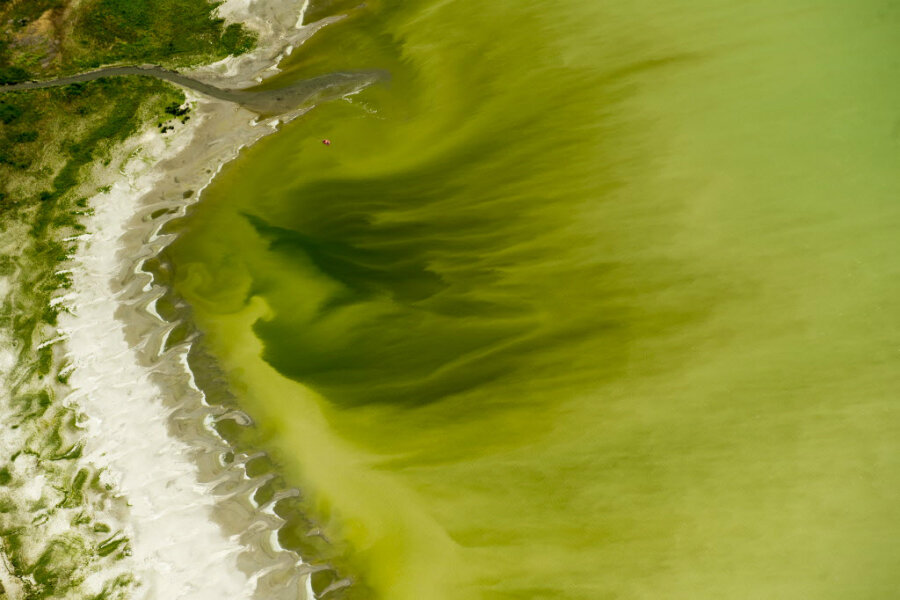Are algae blooms becoming more common?
Loading...
It’s gooey, it’s green, and it’s growing.
Dense algae blooms, such the ones clogging waterways from Florida to Ohio, could become more common with climate warming, researchers say. That's bad news not just for swimmers hoping for clean water in which to take a cool dip, but also for aquatic organisms living in the nation's rivers, lakes, and bays. Getting a handle on the relationship between climate change and algae blooms could help inform ecosystem management and climate mitigation practices.
That viscous green goo, which seems to be everywhere this summer, is not actually algae. Rather, it is composed of cyanobacteria, which is often called “blue-green algae.” Cyanobacteria thrive on two main nutrients: phosphorus and nitrogen. Both are commonly found in fertilizers, and can end up in waterways through runoff.
Because cyanobacteria are partial to warm, calm waters, some researchers suggest that warming climates will bring more frequent algae blooms. As with many aspects of climate change, however, causative conclusions can be difficult to draw from corollary evidence, Richard Stumpf, a NOAA researcher who specializes in harmful algal booms explains.
“In longer warm seasons, you are potentially more likely to have [blooms],” Dr. Stumpf tells The Christian Science Monitor. “But can we say that they’ve been changing due to climate? That would be hard to say.”
In 2009, however, Hans Paerl, professor at the University of North Carolina’s Institute of Marine Sciences, published research that specifically linked the expansion of cyanobacterial blooms to climate change. According to his research, a number of climate change indicators encourage cyanobacterial growth.
General warming could benefit cyanobacteria, Dr. Paerl tells the Monitor in a telephone interview, but much of the effect occurs in surface water. As lakes and estuaries warm, they experience density stratification, where the surface water becomes increasingly warmer relative to the deeper water below. Cyanobacteria, which prefer to live near the surface anyway, are additionally favored.
Other factors of climate change, such as changes in rainfall patterns or extreme drought, could also lead to algal growth.
“If you get more intense rainfall events, you’re going to get more nutrient runoff from farmland and urban centers,” Paerl says. “If that’s followed by a drought, it becomes a perfect storm scenario. Droughts lead to long residence times, where the water does not move in or out of the system, and that benefits blooms as well.”
“No matter how you slice or dice it, all the indicators of climate change seem to favor these types of blooms,” Paerl adds.
Large blooms are also spreading geographically. Last month, researchers found that pink-tinted Arctic snow was the result of self-perpetuating Chlamydomonas nivalis algae. Meanwhile, 33 square miles of Florida’s Lake Okeechobee has been covered in green algal slime.
The trend is particularly noticeable at higher latitudes – places like northern Europe and Canada, where warming has prevented lakes from freezing over. In those places, cyanobacteria have a longer window of opportunity to bloom.
Florida’s tourism economy has suffered a significant blow as a result of recent blooms. Algae can also be an environmental menace, killing off fish and rooted aquatic vegetation by depleting oxygen and blocking light.
“One of the big problems with these blooms is that when they really get going, you get a paint-like mat on the surface [and] it blocks the light from going down below the surface,” Paerl says. “So it’s the algae that are able to use the light, and everything else is choked off essentially.”
“There’s an estuary out on Monterey Bay, and they’ve had sea otter deaths,” Stumpf says. “Mussels and oysters, which the otters often eat, took in the cyanobacteria, which is toxic to mammals.”
In previous decades, researchers could control a harmful bloom by cutting off just one of its nutrient sources. But after years of agricultural growth and urbanization, that’s no longer enough. Modern treatments must target both nitrogen and phosphorus to work effectively.
Bloom management has proven difficult in places like Lake Okeechobee, where nutrient loading can come from multiple sources. Point sources, such as wastewater treatment plants or pipelines, are easy to identify and therefore treat. Nonpoint sources, which include runoff from farmland, are more difficult to locate.
“The low-hanging fruit has been to go after the point sources, but in many instances, the nonpoint sources often exceed them,” Paerl says.
Once those sources are identified, they can be treated. Nutrient treatments can cost thousands of dollars per day, but researchers say it’s time for humankind foot the bill.
“I would argue that we have benefited immensely from using chemical fertilizers,” Paerl says, “but it’s time now to pay back Mother Nature.”






